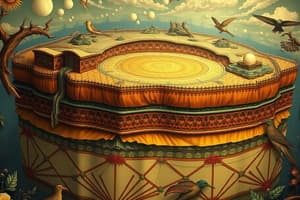Podcast
Questions and Answers
What is responsible for causing the movement of tectonic plates?
What is responsible for causing the movement of tectonic plates?
- Convection currents in the mantle (correct)
- Gravity from the Earth's core
- Volcanic eruptions
- Continents pulling them apart
What is the primary focus of Chapter 2 in the NCERT Geography textbook for Class 9?
What is the primary focus of Chapter 2 in the NCERT Geography textbook for Class 9?
- The continents and oceans
- The movement of tectonic plates
- The formation of mountains and valleys
- The composition of the lithosphere (correct)
What are the three types of tectonic plates mentioned in Chapter 2?
What are the three types of tectonic plates mentioned in Chapter 2?
- Sedimentary, metamorphic, and igneous
- Internal, external, and convergent
- Continental, oceanic, and convergent (correct)
- Underground, underwater, and convergent
What has the movement of tectonic plates created?
What has the movement of tectonic plates created?
What causes earthquakes?
What causes earthquakes?
What is a potential result of earthquakes?
What is a potential result of earthquakes?
How do volcanoes form?
How do volcanoes form?
What process leads to the formation of mountains?
What process leads to the formation of mountains?
What activity helps students understand the distribution of continents and oceans on the Earth's surface?
What activity helps students understand the distribution of continents and oceans on the Earth's surface?
Which practical activity involves simulating volcanic eruptions?
Which practical activity involves simulating volcanic eruptions?
Study Notes
Geography Class 9 NCERT Book Chapter 2: Exploring Earth's Features and Processes
In this educational and informative article, we'll delve into the NCERT (National Council of Educational Research and Training) textbook for Class 9 Geography, specifically focusing on Chapter 2: "Our Earth - The Lithosphere." As we explore the chapter, we'll highlight key concepts and provide context to help you better understand the intricacies of Earth's geographical features and processes.
Chapter Overview
This chapter introduces students to the lithosphere - the outermost layer of the Earth's crust. It examines the Earth's features and processes, looking at the continents, oceans, and Earth's crust. The chapter discusses the following topics:
-
Continental Drift and Plate Tectonics: The continents have moved over time, and the Earth's crust is made up of several tectonic plates that are continuously shifting against one another. This movement has created mountains, valleys, and ocean basins.
-
The Lithosphere's Composition: The lithosphere is a mix of rocks and soil, and it is composed of the crust and the uppermost part of the mantle. It is broken down into three types of tectonic plates: continental, oceanic, and convergent.
-
Movement of Tectonic Plates: Plates move due to convection currents in the mantle, causing them to collide, diverge, or subduct. These processes create various landforms, including mountains, valleys, and ocean basins.
-
Earthquakes: Earthquakes occur when the landmasses shift suddenly, releasing energy that causes the ground to shake. These earthquakes can result in significant damage to infrastructure and cause tsunamis and aftershocks.
-
Volcanic Activity: Volcanoes form when magma, molten rock, and gases rise to the Earth's surface. They can create new landforms, such as islands, and can also contribute to soil formation.
-
Orogeny: Orogeny is the process by which mountains are formed. It happens when two tectonic plates collide, causing the rocks to be pushed upward into the air.
Practical Activities
The chapter provides several practical activities to help students engage with the material and reinforce their learning. These include:
- Map work: Students use maps to understand the distribution of continents and oceans on the Earth's surface.
- Tectonic plate models: Students build models of the Earth's tectonic plates to better understand how they move and interact with one another.
- Earthquake simulations: Students simulate earthquakes using materials like sand and marbles to understand how seismic waves travel through the Earth.
- Volcanic eruption simulations: Students simulate volcanic eruptions using baking soda and vinegar to understand how magma and gases travel through the Earth's crust.
Conclusion
NCERT's Class 9 Geography Chapter 2 is a valuable resource for students looking to understand the Earth's lithosphere, geological features, and processes. By engaging with the material, using maps and models, and participating in practical activities, students can gain a deeper understanding of Earth's complex geological systems. This knowledge will not only prepare students for further study in geography, but also help them appreciate the intricate beauty of our Earth.
Studying That Suits You
Use AI to generate personalized quizzes and flashcards to suit your learning preferences.
Description
Test your knowledge of lithosphere, continental drift, tectonic plates, earthquakes, volcanic activity, and orogeny with this quiz based on Chapter 2 of the Class 9 Geography NCERT textbook. Explore key concepts and practical activities related to Earth's geographical features and processes.




